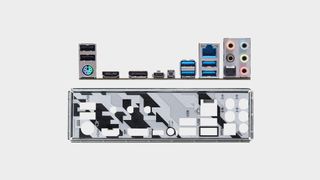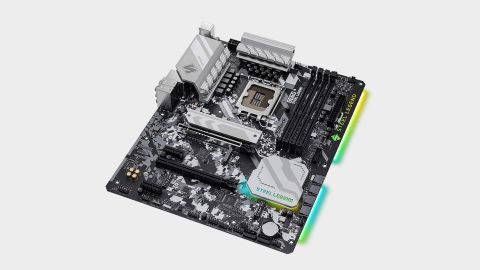Our Verdict
The B660 Steel Legend won’t take home best of the year honors, but it does what it says on the box with no fuss, and that’s all we expect of it.
For
- PCIe 5.0 x16 slot
- Reasonable VRM and cooling
- USB 3.2 Gen 2x2 case header
Against
- No Wi-Fi
- Limited max USB count
PC Gamer's got your back
It's a rather sad state of affairs when a mid-range Z690 board costs upwards of $300. In this market, even the $500 boards we've seen don't really count as high end. That kind of price creep means that B660 boards have been elevated to fill a gap that's opened up between entry level boards and cheaper Z series boards.
Some cheaper B660 boards are exactly that: cheap. But others have a strong VRM game and are perfectly happy to run a Core i9 12900K at stock speeds. Now that B series boards include memory OC support, there are fewer reasons than ever to spend a lot more money on a Z series board.
That brings us to ASRock's B660 Steel Legend. It's a DDR4 board and there isn’t a DDR5 option. That spec alone puts it in the more affordable category, and will have a large impact on total system cost, too with the price of the latest memory tech.
At the time of writing the B660 Steel Legend isn't yet available in many markets, but with a price at Scan in the UK £160, and the micro ATX version costing $150 at Newegg, we can estimate that it will end up around $160 US or perhaps $280 AUD.
That puts it in the mid-range of B660 pricing and, at that kind of price, it's important not to expect too much. Though if you think about it, you can add an i5 and 32GB of DDR4-3200, with your choice of GPU, and it should easily be able to sit at the heart of an eminently affordable gaming system. But the big question is: Do you have to give up a lot of important features compared to more expensive motherboards?
Socket: Intel LGA 1700
Form factor: ATX
Memory support: 128GB | Up to DDR4-4800
Storage: 3x M.2; 6x SATA
USB: Up to 1x USB 3.2 Gen 2x2, 1x USB 3.2 Gen 2, 6x USB 3.1 Gen 1, 4x USB 2.0
Video out: 1x HDMI 2.1; 1x DP 1.4
Networking: Realtek RTL8125BG 2.5G LAN
Audio: Realtek ALC897 7.1 Channel HD Audio
Price: $160 | £160
The B660 Steel Legend features a military themed PCB with white and grey heatsinks, and unsurprisingly looks very similar to the B560 Steel Legend. It comes with some large splashes of RGB lighting around the right side and chipset heatsink. It also appears very bright, almost too bright.
One of the highlights is the inclusion of a PCIe 5.0 slot, which is omitted on many B660 boards to provide feature set differentiation with more expensive options. There are three M.2 slots, though only the primary slot has a heatsink. The middle one also only runs at PCIe 3.0 x2 speed. There are two PCIe 1x slots which immediately puts it ahead of many boards in its price range for the ability to add multiple expansion cards.
Its easy to forget that we’re talking about a cheaper board, but these days it's hard to get past the omission of Wi-Fi, though the Steel Legend does have an M.2 e-key slot for a Wi-Fi card if you want to add wireless capabilities down the line. You do also have to settle for basic Realtek ALC897 audio, too. Note that the board features a USB 3.2 Gen 2x2 front panel header, however, which is nice to see in this price range.

It does bear saying that the VRM of the B660 Steel Legend is on the basic side, but we have to remember we aren't dealing with a $500+ motherboard here. A DrMOS VRM with nine 50A phases is able to power an i9 12900K. Usually we like to report the VRM temperature during a stress test, however the beta version of HWinfo we were using didn't report the temperature correctly with our i5 chip. It sure as heck wasn't the 6°C it was reporting.
So, we attached a thermocouple to the heatsink. We recorded a temperature of 42°C. Even if the true temperature is over 10°C higher, that's not a bad result given the relatively skinny heatsinks. The load of a 12900K will be higher, so if you’re one of the few that plan to pair a 12900K with a B660 Steel Legend, you’ll need decent airflow.
The rear I/O comes with a typical set of ports in this price range, though Wi-Fi is the obvious omission. There’s one Type-C USB 3.2 10Gb/s port, four 3.2 5Gb/s ports and two USB 2.0 ports. The problem with having only seven USB ports is that once you add a keyboard and mouse, a printer, headset, an external hard drive, and a phone cable and you’re down to one. Okay, you have headers for a case and can always add a hub but not everyone wants cables hanging off of the front of their chassis.
You get DisplayPort 1.4 and HDMI 2.1 ports for use with Intel’s Xe graphics, a PS/2 keyboard/mouse connector, and a BIOS flashback button. There’s a single 2.5G ethernet port, which is controlled by a Realtek RTL8125BG chip. Finally, there’s the audio. S/PDIF is a welcome for connection to an external amp or DAC, but the audio codec is the very generic ALC897. You do get Nahimic software support and the implementation isn't bad, but if you're looking for a high-quality audio solution, you’ll have to look further up in the range.
Gaming performance




System performance







The straight performance of the board, however, was generally good. It beat out the highly regarded MSI B660 Tomahawk more often than not, though, as we always say, the differences between like-for-like systems and motherboards is generally small, if not within a margin of error. The Steel Legend doesn't have any problem with a Core i5 12600K, and with an unlikely pairing of an RTX 3080 Ti, the board performs on par with a DDR4-serviced Z690 board.


The ASRock B660 Steel Legend is a fairly unremarkable board, but at this price, you don't really want anything else. 'Remarkable' at this level generally references something less than positive, so a board that doesn't cause a scene is really what you're after.
If you want an overclocking-capable VRM, or Wi-Fi 6E connectivity, you have to pay twice the price or a lot more. This is a board for users on a budget, though does offer PCIe 5.0 support. Chuck in an i5 and your old set of DDR4 memory and you’ve got the core of a no fuss budget system.
The B660 Steel Legend may be unremarkable—perhaps even average—but if you’re struggling to afford a GPU, saving a couple of hundred on a board like the B660 Steel Legend and diverting it to a GPU will add tangible performance to your gaming system.
The B660 Steel Legend won’t take home best of the year honors, but it does what it says on the box with no fuss, and that’s all we expect of it.

Chris' gaming experiences go back to the mid-nineties when he conned his parents into buying an 'educational PC' that was conveniently overpowered to play Doom and Tie Fighter. He developed a love of extreme overclocking that destroyed his savings despite the cheaper hardware on offer via his job at a PC store. To afford more LN2 he began moonlighting as a reviewer for VR-Zone before jumping the fence to work for MSI Australia. Since then, he's gone back to journalism, enthusiastically reviewing the latest and greatest components for PC & Tech Authority, PC Powerplay and currently Australian Personal Computer magazine and PC Gamer. Chris still puts far too many hours into Borderlands 3, always striving to become a more efficient killer.
